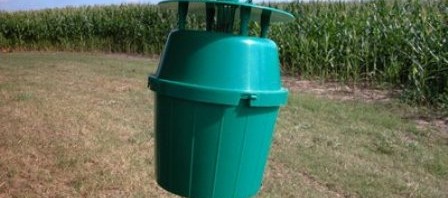I previously posted a blog article about utilizing pheromone moth traps for monitoring populations of southwestern corn borer, SWCB (http://www.utcrops.com/news/2011/03/southwestern-corn-borer-moth-traps/). There is a link within this article on how to interpret and make decisions based on the numbers of moths being caught. If you look at moth trap counts
for this year, you will notice some areas catching very few moths. Other areas are catching 20 – 60 moths per week. Running traps is of little value unless you are going to use the data. Below are some bullet points for your consideration.
- Only be concerned about southwestern corn borer in non-Bt corn. All commercially available Bt traits provide near perfect control of corn borers (including European corn borer). Late maturing non-Bt corn is at higher risk.
- Run your traps weekly throughout the season (mid May – early to mid August). You are less likely to need to treat for first generation infestations because they tend to be smaller and more isolated. However, early (1st generation) moth catches are very predictive of potential second generation problems. In my experience, if you only catch 0-10 SWCB moths per week during the first generation, the chances of having a serious infestation during the second generation are pretty small. But you need at least 2-3 traps in an area to get a good average.
- The first generation moth flight usually peaks in mid to late May. The second generation usually begins in early July and peaks from July 10-20. Thus, early corn can “outrun” the second generation.
- You may catch a lot of moths during the first generation even if you have nothing but Bt corn in the field. Why? The first moth flight is from overwintering larvae, so it is dependent upon infestations in non-Bt corn from the previous season.
- High moth catches often precede obvious signs of infestation in the field by 7-10 days. So this gives you a little time to react. This is especially important as it is necessary to make any treatments before most larvae have begun tunneling into stalks (making control difficult).
- First generation moth catches that peak at 20+ moths per week indicate potential for problems in some fields and on a wider scale during the next generation. Scouting should be initiated in all non-Bt fields in the area. Catching 40+ moths is a red flag, and treatment of some corn during the whorl stage may be justified.
- The second generation peak is typically 5-10 fold the size of the first generation and will persist for longer. Of course, if there is very little non-Bt corn nearby, the second generation will not be as big.
- A second generation peak of 100+ moths indicates some potential problems, but a peak above 200+ moths should definitely catch your attention. This indicates you already had a fairly successful 1st generation, and the area at risk will have spread out. Late planted non-Bt corn will be at especially high risk, and you should consider treatment.
Refer to our fact sheet on SWCB and European corn borer, scouting and their management at the websites below.
http://www.utextension.utk.edu/fieldCrops/corn/corn_insects/SWCB.htm
http://www.utextension.utk.edu/fieldCrops/corn/corn_insects/ECB.htm



